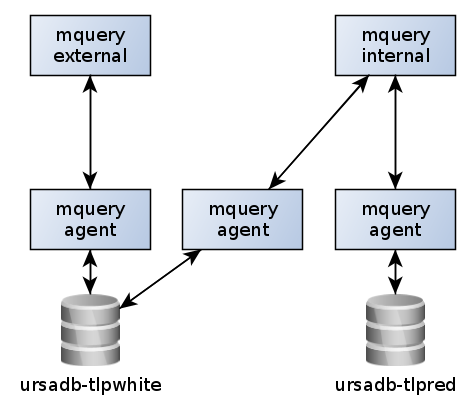components
There are four main independent components in mquery deployments:
- web frontend
- daemons (also called “agents” or “workers”)
- UrsaDB (backend database)
- Redis
In a normal situation, there is one web frontend, one shared Redis database, and for every UrsaDB instance, there is a group of one or more agents dedicated to it:

In most small-to-medium sized deployments there is only one ursadb instance, and all workers are assigned to it.
More complex configurations are possible, for example, consider this deployment with internal and external sample index:

Web frontend (mquery)
Mquery is a standard web application written in Python (using the Fastapi framework).
It talks with Redis directly, and schedules tasks for the workers.
For some administrative tasks (like checking ongoing tasks) it also sends requests to UrsaDB directly.
Mquery daemon (agent)
The workhorse of the entire setup. There must be at least one daemon for every UrsaDB instance. Daemon’s tasks include querying the assigned UrsaDB instance for samples and running YARA rules on candidate samples.
Redis
It’s a shared database that’s used for several purposes. The main one being communication between daemon and mquery. It is also used as a task queue for jobs scheduled for agents. And it’s also used for persistent storage of job results. Finally, it’s utilized to store plugin configuration and job cache for agents. To sum up, it’s pretty overloaded and used to store everything as the main database of the project.
UrsaDB
Ursadb is a separate project, used in mquery as a backend database to optimise YARA rules. Ursadb itself has no understanding of YARA syntax, so all rules are first transpiled by mquery to a simpler Ursadb syntax before a query.